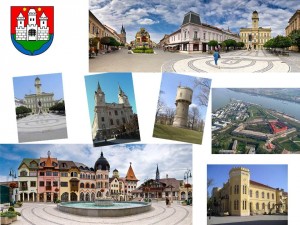- a town in the south- west of Slovakia
- area: 103,17 km2
- population: 34 478
- Slovakia’s principal port on the Danube
- centre of the Hungarian community in Slovakia
Geography
- located at the confluence of the rivers Danube and Vagh
- Komarno is also known as „The Gibraltar on the Danube“
- the Danube creates here a natural border between the countries Slovakia and Hungary
- the southernmost town and it has the lowest location in Slovakia
- good location: 100 km from 2 capital cities: Bratislava/Slovakia/ and Budapest /Hungary/
History
- old town with a rich history
- its territory has been inhabited since the Early Bronze Age
- King Béla IV in his charter in 1265 granted the settlement town status and privileges
- these privileges contributed to the development of medieval Komárom, helping it establish a flourishing trade market and craft industry
- Medieval Komárno prospered, especially under the reign of Mathias Corvinus, who
built a renaissance palace within the castle complex and frequented it for rest and pleasure
- in the 18th century, after the end of the Turkish wars and expulsion of the Turks from the region, Komárno, one of the biggest towns in the country, began to flourish
- Maria Theresia’s charter in 1745 granted Komárno the status and privilege of a free royal town
- during the 18th century Komárno experienced many natural disasters including floods, fires, earthquakes, cholera and plague epidemics
- despite these calamities, Komárno continued to be an important centre for trade and crafts until the middle of the 19th century
Personalities
- Komarno is a birth place of many famous people →for example: Franz Lehár(1870-1948) /a composer/, The King Ladislaus the Posthumous, Mór Jókai (1825-1904) /a famous Hungarian writer/
- Hans Selye /who is known as an author of the stress theory/ grew up here
- nowadays the town has many succesful sportsmen
Sights
- Europe Place: a modern complex of buildings, it represents the typical architecture of all european countries,it was built in 2000
- Church of Saint Andrew: built in 1723, many times renovated, nowadays in the late-Baroque style with elements of Classical style
- The fortification system of Komarno: dominant of the town, the largest uncaptured fortification system in Europe, national cultural monument, both the Old and New Fortresses successfully resisted the attacks of the Turkish army during the course of the Turkish wars
- Town hall: most typical neoreneissance monument in Komárno, built in 1875, creates the heart of the historical centre
- Officer pavillion: built in 1863
Events
- Komárno days: the celebration takes 7 days,during these days you can enjoy many cultural and sport events, for example: concerts of popular Slovak singers or traditional folklore groups

